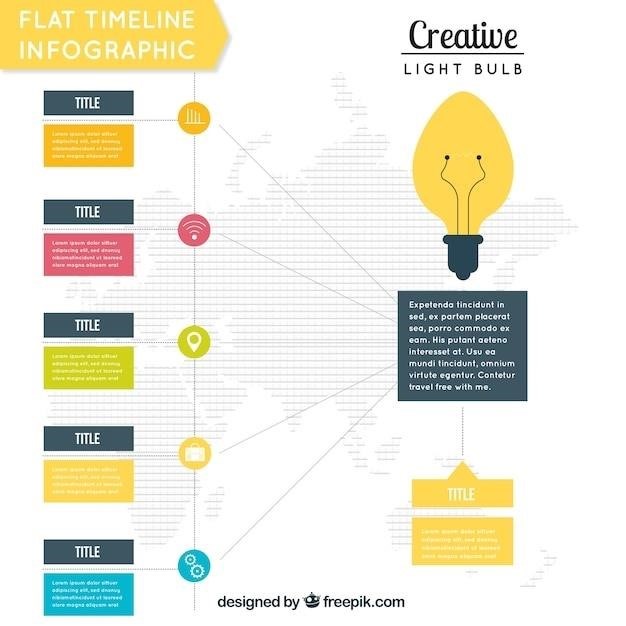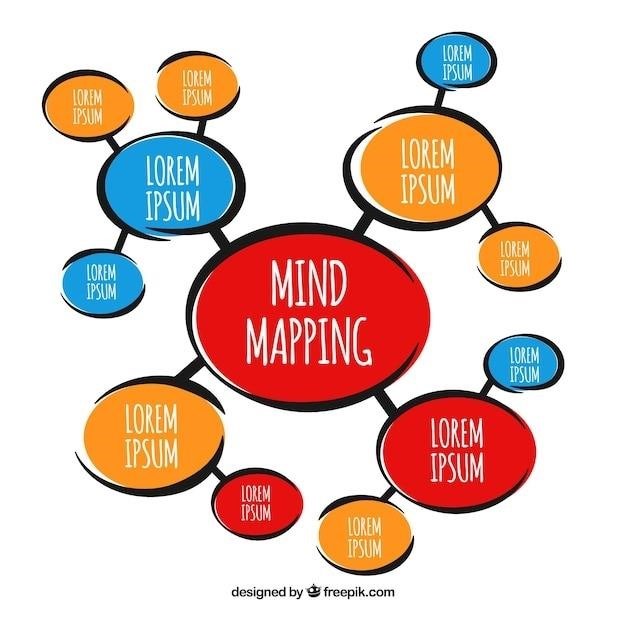Central Idea Graphic Organizers⁚ A Guide for Effective Learning
Central idea graphic organizers are visual tools that help students understand and organize information by identifying the main idea and supporting details of a text. They provide a structured framework for students to analyze and synthesize information, making it easier to remember and recall key concepts. These organizers can be particularly helpful for students who struggle with reading comprehension or have difficulty organizing their thoughts.

Introduction⁚ The Importance of Central Idea Graphic Organizers
In the realm of education, effective learning hinges on the ability to comprehend and retain information. Central idea graphic organizers emerge as invaluable tools in this endeavor, empowering students to navigate complex texts and extract crucial insights. These organizers serve as visual blueprints, guiding learners through the intricate landscape of ideas and facilitating a deeper understanding of the material. By visually representing the core message and its supporting evidence, central idea graphic organizers transform passive reading into an active and engaging process.
Imagine a student grappling with a dense historical passage. The central idea graphic organizer provides a structured framework, enabling them to dissect the text, identify the central theme, and pinpoint the supporting details that illuminate the main idea. This process not only enhances comprehension but also fosters critical thinking skills, as students analyze relationships between concepts and discern the author’s intent. The visual nature of these organizers appeals to diverse learning styles, making them accessible and effective for a wide range of students.
In essence, central idea graphic organizers act as catalysts for effective learning. They bridge the gap between passive reading and active comprehension, fostering a deeper understanding of the material and equipping students with the tools to navigate complex texts with confidence.
Types of Central Idea Graphic Organizers
The world of central idea graphic organizers boasts a diverse array of formats, each tailored to specific learning objectives and content types. These organizers can be categorized into several common types, each offering unique advantages for students and educators.
One popular type is the Main Idea and Details Chart, a simple yet effective organizer that encourages students to identify the central idea of a text and list supporting details. This chart provides a clear visual representation of the hierarchical structure of information, helping students grasp the relationship between the main idea and its supporting evidence.
Another widely used type is the Venn Diagram, which is particularly effective for comparing and contrasting two or more concepts. This visual tool allows students to identify similarities and differences between ideas, promoting deeper analysis and critical thinking.
For analyzing complex characters or themes in literature, Character Maps and Theme Webs provide valuable frameworks. Character maps visually represent a character’s traits, motivations, and relationships, while theme webs explore the intricate connections between different themes within a text.
The versatility of central idea graphic organizers extends beyond the realm of reading comprehension. They can be effectively used in various subjects, from science and history to math and language arts, providing a structured framework for organizing information and fostering a deeper understanding of concepts.
How to Use Central Idea Graphic Organizers
Central idea graphic organizers are versatile tools that can be incorporated into various learning activities. To effectively utilize these organizers, follow a step-by-step approach that guides students through the process of identifying and organizing information.
First, introduce the concept of the central idea and its importance in understanding a text. Explain that the central idea is the main point or message that the author is trying to convey. Encourage students to actively read the text, looking for clues about the main idea.
Next, guide students through the process of selecting a suitable graphic organizer for the specific text and learning objective. Consider the complexity of the text, the type of information being analyzed, and the learning goals.
Once the organizer is chosen, model how to fill it out using a sample text. Demonstrate how to identify the main idea and supporting details, and how to organize this information within the organizer’s framework.
Finally, allow students to practice using the organizer independently, providing support as needed. Encourage them to actively engage with the text, looking for evidence to support their findings. Review the completed organizers, discussing any challenges or insights gained.
By following these steps, students can learn to effectively use central idea graphic organizers to enhance their reading comprehension, improve their critical thinking skills, and develop a deeper understanding of the content they are learning.
Benefits of Using Central Idea Graphic Organizers
Central idea graphic organizers offer numerous benefits for students of all ages and learning styles. These visual tools not only enhance reading comprehension but also foster critical thinking, organization, and communication skills.
By providing a structured framework for organizing information, graphic organizers help students break down complex texts into manageable chunks. This visual representation makes it easier for students to identify the main idea and supporting details, leading to a deeper understanding of the content.
Furthermore, the process of completing a central idea graphic organizer encourages active reading and critical thinking. Students must analyze the text, identify key concepts, and make connections between the main idea and its supporting evidence. This active engagement promotes a deeper level of understanding and retention.
The use of graphic organizers also improves students’ organizational and communication skills. They learn to structure their thoughts logically, present information clearly, and express their understanding effectively. This improved organization and communication can benefit students in various academic and life contexts.
In conclusion, central idea graphic organizers offer a powerful tool for enhancing learning and promoting student success. Their ability to improve reading comprehension, critical thinking, and organizational skills makes them a valuable asset in any educational setting.

Examples of Central Idea Graphic Organizers
There are various types of central idea graphic organizers, each designed to cater to different learning styles and text structures. Some popular examples include⁚
- Main Idea and Details Chart⁚ This simple organizer features a space for the main idea and several lines for listing supporting details. It’s ideal for identifying key concepts and their supporting evidence.
- Venn Diagram⁚ Venn diagrams are useful for comparing and contrasting two or more concepts or texts. They help students analyze similarities and differences, leading to a deeper understanding of each subject.
- KWL Chart⁚ KWL charts are used to activate prior knowledge and track learning. They encourage students to consider what they already know (K), what they want to learn (W), and what they have learned (L) after reading a text.
- Five Ws Chart⁚ This organizer helps students gather information by prompting them to answer the five W questions⁚ who, what, when, where, and why. It’s particularly effective for summarizing factual information or analyzing events.
These are just a few examples of central idea graphic organizers. Numerous other templates are available online and in educational resources, allowing educators to choose the best option for their students and curriculum;
Creating Your Own Central Idea Graphic Organizer
While numerous pre-made graphic organizers are available, creating your own can be highly beneficial. It allows you to tailor the organizer to the specific text or topic you are studying, making it more relevant and engaging for students. Here are some steps for creating your own central idea graphic organizer⁚
- Identify the Learning Objective⁚ What do you want students to understand or learn from the text? This will guide the structure and content of your organizer.
- Choose a Format⁚ Consider the type of text and the learning objective. Would a chart, web, or flowchart be most effective?
- Determine Key Elements⁚ What are the essential components of the text or topic? These should be included in your organizer as headings or sections.
- Add Visual Cues⁚ Use visuals like boxes, lines, arrows, or color to make the organizer visually appealing and easier to understand.
- Provide Instructions⁚ Clearly explain how to use the organizer and what students should fill in each section.
Remember, the goal is to create a tool that supports students in identifying the central idea and understanding the supporting details. By customizing the organizer, you can make the learning process more engaging and effective.
Tips for Using Central Idea Graphic Organizers Effectively
Central idea graphic organizers can be a valuable tool for students, but their effectiveness depends on how they are implemented. Here are some tips for using them effectively⁚
- Model and Explain⁚ Before asking students to use the organizer independently, model how to use it with a sample text. Explain the purpose of each section and how to fill it in.
- Provide Guidance⁚ During the first few uses, offer guidance and support to students. Encourage them to ask questions and provide feedback on their work.
- Differentiate Instruction⁚ Adapt the organizer to meet the needs of diverse learners. For example, provide more scaffolding for students who are struggling or challenge advanced learners with more complex texts.
- Integrate with Other Activities⁚ Don’t treat the organizer as a stand-alone activity. Integrate it into other classroom activities, such as reading comprehension, writing, or discussions.
- Encourage Collaboration⁚ Allow students to work together to complete the organizer. This can foster discussion and help them learn from each other.
By using these tips, you can help students make the most of central idea graphic organizers and enhance their understanding of text and content.
The Power of Central Idea Graphic Organizers
Central idea graphic organizers are a powerful tool for improving reading comprehension and critical thinking skills. They offer a structured approach to analyzing and synthesizing information, making it easier for students to identify the main idea and supporting details of a text. By providing a visual representation of the information, these organizers enhance memory and recall, making learning more effective and engaging.
Whether used for guided reading activities, independent learning, or collaborative projects, central idea graphic organizers can be adapted to various learning styles and needs. They empower students to take ownership of their learning, develop deeper understanding, and become more confident and proficient readers and learners.
In today’s information-rich world, the ability to analyze and synthesize information effectively is crucial. Central idea graphic organizers provide a valuable framework for developing these essential skills, setting students up for success in all areas of their academic and personal lives.
Resources⁚ Finding Central Idea Graphic Organizers
Finding a central idea graphic organizer that fits your needs is easier than ever. A simple online search can reveal a wealth of resources, including free printable templates and interactive digital tools. Many educational websites, such as Educational Networks and HMH, offer free graphic organizer templates specifically designed for identifying the main idea and supporting details in texts.
These resources often provide a variety of graphic organizers, catering to different learning styles and grade levels. For example, you might find templates featuring charts, diagrams, webs, or even simple outlines. Additionally, some websites offer customizable templates, allowing teachers or parents to tailor the organizer to specific learning goals and content.
Beyond individual websites, platforms like Teachers Pay Teachers and Etsy offer a wider selection of both free and paid graphic organizers. These marketplaces often feature high-quality, teacher-created materials, ensuring a range of options for all learning scenarios. Whether searching for a quick, printable worksheet or a more interactive digital tool, a variety of resources are readily available to help students harness the power of central idea graphic organizers.

